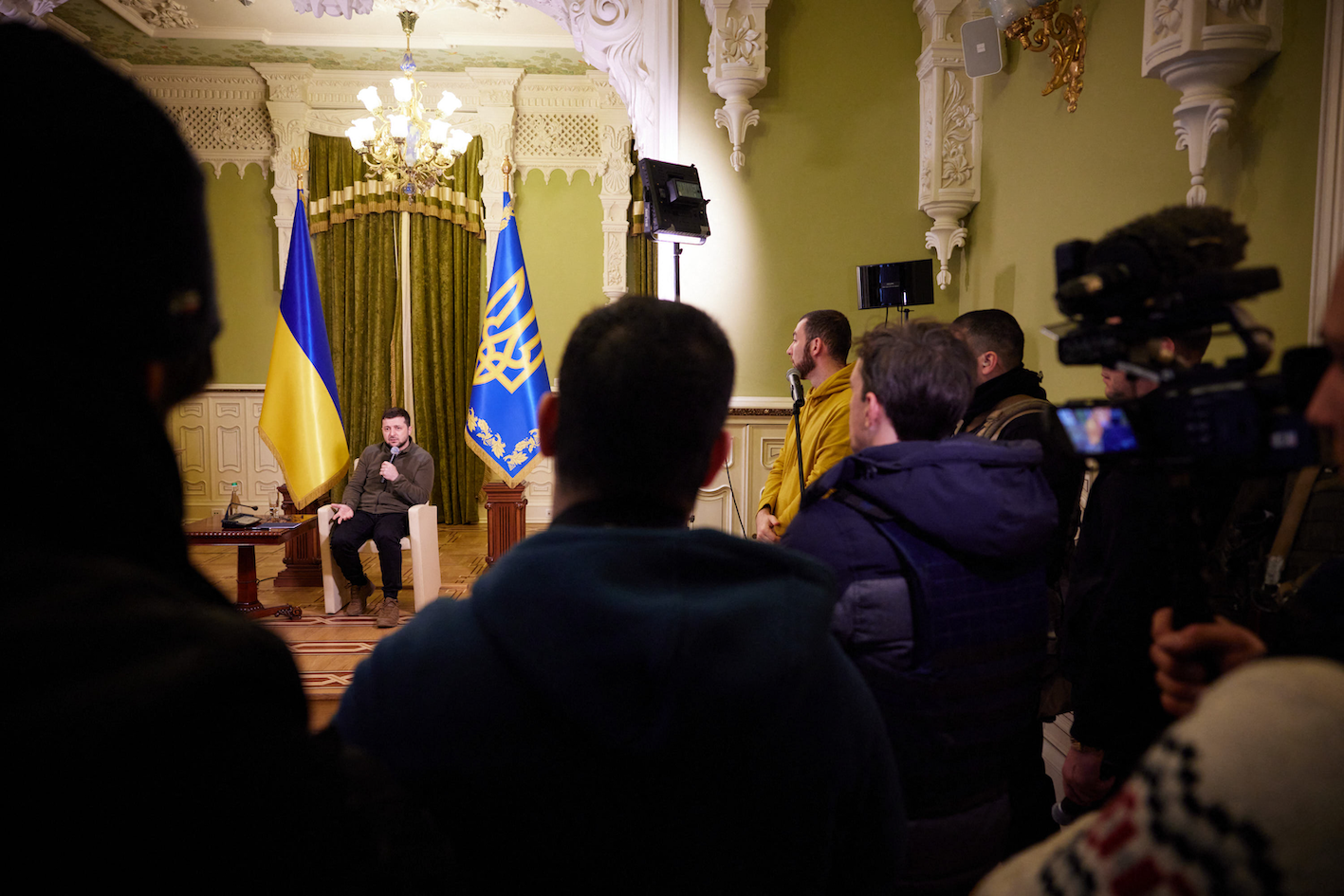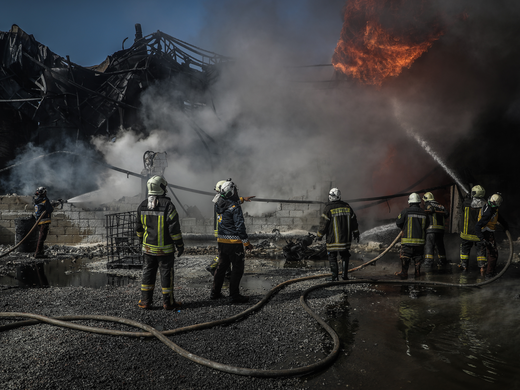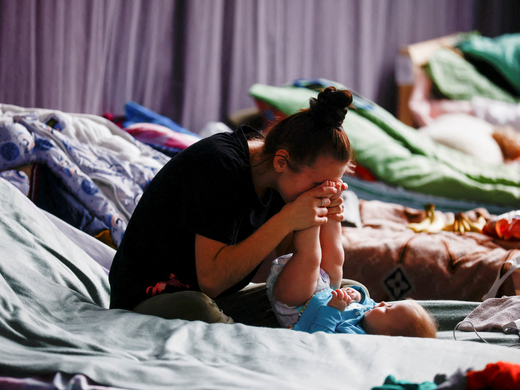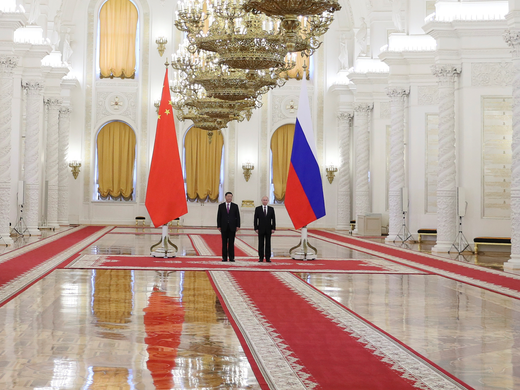Russia’s invasion of Ukraine shell-shocked the world. The war has monopolized headlines in print and broadcast media and unleashed a torrent of instant analysis and professional commentary. And it has flooded social media platforms. Indeed, I’ve been thinking about how social media has been weaponized, not only during the hostilities but well before this particular conflict erupted, and to what effect.
The First Social Media War
Russia’s invasion of Ukraine has been described as the first full-blown “social media war.” It also charts new territory in other ways because of the digital transformation. This is the first full-blown cyber war and the first hacker war featuring both state and non-state actors attacking the information infrastructures of the combatants.
Further, with 20/20 hindsight, it’s stunning to realize the extent of the groundwork for the invasion laid down antebellum through Russia’s influence campaign to weaken the parties that could potentially come to Ukraine’s aid. This includes buying “Londongrad”; the kompromat (compromise) of Donald Trump and influence over the Republican Party, including through Fox News; and more generally the sowing of divisiveness in Western societies through manipulation of social media. For example, there were significant correlations observed between the support for the Canadian truckers’ convoy and the US Capitol riots of January 6, 2021, which in turn are linked to the Russian-compromised circles around Donald Trump. Similarly, there were strong links between the backers of Brexit and the Trump campaign, as uncovered by award-winning journalist Carole Cadwalladr.
Technological conditions determine how wars are communicated. However, these technological conditions apply to both sides.
For Ukraine, social media provides new channels to disseminate information about the conduct of the war in small fragments, which ultimately create a mosaic for netizens. This conduit helps preserve internal resolve to resist and helps build external support for assistance. It also continuously contributes to the documentary record that will ultimately shape historical narratives and — as is increasingly likely — support war crimes charges.
For Russia, social media is another channel in which the “fog of war” must be generated. Wars of choice constitute a crime per se, and, insofar as the crime scene cannot be hidden (for example, the atrocities in Bucha), a campaign is launched to sow doubt about what is seen (as we have heard in reports of Russian officials’ using social media to deny, and indeed invert, the story abroad, while suppressing and sanitizing it domestically).
This is just the latest instance in which changed technological conditions have shaped how wars are communicated. Looking back, the US invasion of Vietnam is often described as the first major “television war,” in that it was the first time that television surpassed print media as the main source of information for the attacking side. It is also described as the first “televised war,” as it brought scenes of war into people’s living rooms, although the footage was heavily edited for American audiences. The choice of what to show and the accompanying narrative remained, therefore, under the control of US television networks.
Although some have described the 1999 Yugoslavian Civil War as the first internet war, with the internet serving as a source of news dissemination, the 2003 US invasion of Iraq can be considered the first major internet war, in which “warblogs” gained readership rivalling that of the major political opinion journals and fact-checkers challenged accounts in the mainstream media. Nonetheless, impressionistically, communication of the US invasion of Iraq was dominated by the cable news networks, which continuously cycled reports from correspondents broadcasting live from Baghdad — but embedded with US troops. The perspective conveyed to most of the world was that of the invading side.
Inside a largely closed Russian internet space, the message is controlled and the narrative is pro-invader. The same is true inside China’s internet space behind the Great Firewall.
The Implications of the Splinternet
Ukraine is different to some extent because this is the first war of the digital era in which the message is not almost entirely controlled by the invading side. It might be better described as the first war of the “splinternet” — the evolution of the internet based on national sovereignty in cyberspace, as per the “Wuzhen Initiative” adopted at the second World Internet Conference in Wuzhen in December 2015.
Inside a largely closed Russian internet space, the message is controlled and the narrative is pro-invader. The same is true inside China’s internet space behind the Great Firewall: the narrative is aligned with Russia’s. To understand the implications, for the average Chinese netizen interpreting the online flow of information, the Russian account of its invasion of Ukraine is to the experience of Ukrainians what Japan’s account of its invasion of China in 1937 was to the experience of Chinese, for example, in the Nanjing Massacre.
Thus, in Russia’s narrative, the Russian invaders of Bucha, a suburb of Kyiv, destroyed nothing, killed no one, and withdrew; they insist that the destruction and death documented by Ukrainian military and political leaders, as well as by international journalists, was a “provocation” perpetrated by Ukraine to defame Russia. Japan similarly sanitized the results of its invasion, mounting, in the words of the author of Perilous Memories, Daqing Yang, “a vigorous propaganda campaign … to portray Nanjing in peace and prosperity under Japan’s benevolent occupation” — in sharp contrast to the reality of the massacre as reported widely abroad, due to the presence of Western journalists in Nanjing at the time, and, of course, as recounted by Chinese survivors.
In the West, the internet is not under sovereign control, but it is contested and subject to heavy influence campaigns. Through platforms such as Twitter, Instagram, Reddit, Telegram and TikTok, Ukrainians have been sharing photos, videos and personal stories. These put a human, relatable face on the war and its impacts, free of the euphemisms and prepared lines of governments, the academic-style analyses by experts and the selectivity of the narratives created by media organizations. A 20-year-old woman documents on TikTok her life in a bunker in Chernihiv under bombardment by Russian invaders, and poses in front of the ruins of apartment buildings destroyed by Russian fire. Alona Zahreba, a ninth-grader in Mariupol, makes a video diary; she bears an uncanny resemblance to another teenager who kept a diary during a war — Anne Frank. Unlike Frank’s diary, which was not published until two years after the war and her death in a Nazi concentration camp, Zahreba’s diary is available now, on YouTube, in (near) real time. We hear the constant presence of bombardment, the account of the daily trials — melting snow for water, surviving a blast from an incoming shell that destroyed the apartment in which she was sheltering, the attempt to keep track of time. We are not sheltered from the horror by the distance of time; and we remain in horror because her fate is not yet told.
Ukrainian President Volodymyr Zelenskyy used to be in show business. He can deliver a line. His daily broadcasts have been critical in maintaining the spirit of defence forces, as well as in providing regular “proof of life” material. But the social media impact, while important because of the immediacy, is likely secondary to the fact that Zelenskyy and his government did not flee.
However, while social media has helped Ukraine get information out, every post is targeted by what appears to be a largely automated, bot-driven disinformation campaign, which mostly aims to create doubt, in order to dissipate the reaction.
Caught in the crossfire, the social media audience must decide for itself whom to believe. Many have argued that we live in a “disinformation age” or a “post-truth world.” Elsewhere, I have argued that humanity has always lived in a “contested truth” world, and so we have evolved an innate ability to detect deception — a “smell test,” if you will.
The open question: How well are people adapting to these changed technological conditions? Propaganda techniques and capabilities gain power in the new digital environment. At the same time, social media networks can help expose propaganda, and the decentralized nature of social media creates new challenges for authorities in controlling narratives. The net effect of the tension between information and disinformation cannot be established on an a priori basis.
Given the discrepancy in power, the invasion is anticipated to occur with overpowering force, with an intent to portray the invasion as a “liberation” and invaders as “saviours” once the deed is done.
An Interim Assessment
Almost invariably, wars feature a predator-prey relationship: they are started by more powerful countries attacking weaker countries in pursuit of some “interest.” Typically, the difference in power is measured in orders of magnitude. Importantly, in the context of the modern information society, power includes what might be termed “market power” in information space, which is manifest in dominant powers being able to control and shape the narratives that individuals adopt and present as their own. In this society, the preparation for war tends to follow a rather simple formula:
- delegitimize the target country;
- demonize the target country;
- list grievances, which legitimize the use of force; and
- concoct a casus belli (a cause for war) to serve as a trigger.
Given the discrepancy in power, the invasion is anticipated to occur with overpowering force (“shock and awe”), with an intent to portray the invasion as a “liberation” and invaders as “saviours” once the deed is done.
Russia’s playbook in its preparation for the invasion of Ukraine followed this template:
- Delegitimization: “Ukraine is not a real country” — although it is a founding member of the United Nations in 1945 and was recognized as such in its then-current borders by Russia upon dissolution of the Soviet Union in 1991.
- Demonization: “Ukraine is full of Nazis” — although the consolidated far-right share of the vote in the last Ukrainian election managed to reach only 2.25 percent (substantially lower than the share of such parties in many liberal democracies) and the far-right failed to win even one seat in Ukraine’s Parliament, not to mention that President Zelenskyy is Jewish.
- A litany of grievances: Russia’s message is that it has been robbed (by transfer of historic Russian lands to Ukraine under the Russian-led Soviet Union); betrayed, by the expansion of the North Atlantic Treaty Organization (NATO) — although Ukraine is not a NATO member; and threatened with mass destruction (Putin: “It would not be an exaggeration to say that the path of forced assimilation [of Russian speakers in Ukraine], the formation of an ethnically pure Ukrainian state, aggressive towards Russia, is comparable in its consequences to the use of weapons of mass destruction against us”). Never mind that Russia’s population is under no threat of Ukrainianization, and that many Ukrainians speak Russian yet identify as Ukrainian.
- The casus belli: An invasion was necessary to stop a genocide in the Donbas — which of course was already occupied by Russian forces!
In 2021, Russia’s population of about 144 million was about four times larger than Ukraine’s population of 44 million; its GDP of US$1.65 trillion (2021) was nine times larger than Ukraine’s US$181 billion. According to DefenseNews, Russia’s defence budget of US$45.8 billion is 11 times larger than Ukraine’s of US$4.2 billion. Russia is a nuclear power, bristling with “tactical” nuclear weapons that guarantee its territorial safety from military attack; Ukraine gave up its nuclear weapons in exchange for a guarantee of its territorial integrity from, inter alia, Russia. Not surprisingly, the war is fought in Ukrainian territory with Russian forces invading. It could not be otherwise.
The countering arguments do not have to make sense or stand up to serious scrutiny — all they have to do to succeed is to be endlessly repeated. This reflects the internet adage known as Brandolini’s law, which holds that the effort required to refute a falsehood is an order of magnitude larger than the effort required to create it in the first place. This is where social media has been something of a game changer. It commands a larger share of a population’s attention than traditional media; the replication of memes is highly scalable through bot accounts; and the techniques developed for the “attention economy” have been put in the service of propaganda for exploitation by seeding doubt and rage.
Thus, when governments have “market power” in information space — as, for example, in Russia — social media appears to be a very powerful tool for shaping public opinion. When information space is contested — as in the much more open internet in much of the rest of the world — there is a pitched battle being waged to set the narrative. How that battle will conclude, which side’s memes and narratives take root in which parts of the world, is as yet unclear. There is no force attrition in this war. There will be no armistice. The tactics and methodologies are evolving, and we are all witting or unwitting participants through our engagement with social media. The heads-up is that “The Art of Memetic War” is being written — in Russian, in English and, undoubtedly, in Chinese. The definitive version awaits, perhaps, a modern Sun Tzu.



